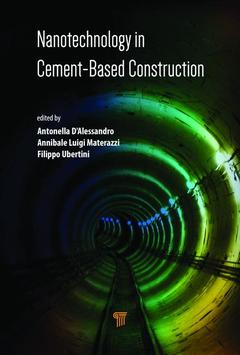Nanotechnology in Cement-Based Construction
Coordonnateurs : D'Alessandro Antonella, Materazzi Annibale Luigi, Ubertini Filippo

Many books on new smart materials are available, but specialized analysis of particular topics is still in high demand. This multiauthor book focuses on applying nanotechnology to cement-based materials to make numerous engineering applications possible. The addition of novel smart nanofillers allows the development of multifunctional composite materials, not just limited to improving mechanical strength, but also including several enhanced features. Special attention is devoted to types of nano-inclusions, novel techniques to mix components, and analysis of properties that can be achieved by paste, mortar, or concrete if added with nanofillers. Among these properties, the capability of self-sensing is very promising. Moreover, the use of phase-changing materials improves the energy efficiency of nanocomposites, resulting in important applications in engineering. Particular attention is also focused on energy harvesting and electromagnetic shielding properties. Comprehensive and up to date, this is an important reference book that not only provides in-depth information about recent developments and perspectives in this field but also discusses topics that promise major developments in the near future.
Nanoinclusions for cementitious materials. Novel dispersion techniques of nanoinclusions in cement matrices. Use of styrene ethylene butylene styrene SEBS for accelerated percolation in composite cement-based sensors filled with carbon black. Advancements in cement-based silica aerogel mortars. Multifunctional cement-based carbon nanocomposites. Analysis and modeling of electromechanical properties of cement-based nanocomposites. Evaluation of mechanical properties of cement-based composites with nanofillers. Micromechanics modeling of nanomodified cement-based composites. Use of nanocarbon cement-based sensors for dynamic monitoring of structures. Strain-sensing concrete for damage detection of structures. Phase-changing materials for enhancing thermal properties of nanocomposites. Cement-based composites with PCMs and nanoinclusions for thermal storage. Self-heating conductive cement-based nanomaterials. Functional composites for energy harvesting and engineering applications: An Overview.
Antonella D’Alessandro is a postdoc researcher of structural design at the Department of Civil and Environmental Engineering, University of Perugia, Italy. She graduated cum laude and obtained her PhD in civil engineering from the University of Perugia in 2012. She has written more than 70 scientific papers and has received many international awards and recognitions. She is a member of scientific committees and project teams. Her research interests include self-sensing nanocomposites, innovative/sustainable materials, structural health monitoring, fire engineering, and earthquake engineering.
Annibale Luigi Materazzi is full professor of structural design at the Department of Civil and Environmental Engineering, University of Perugia. He graduated with honors in civil engineering construction in 1977 and obtained his PhD in structural engineering in 1987 from the University of Rome, Italy. He is a member of scientific committees for standards, projects, and conferences and has more than 80 publications to his name. His research interests include traditional and innovative building materials, wind and fire engineering, the control of passive and active structures, effects of vibrations, and in-service behavior and durability of buildings.
Filippo Ubertini is full professor of structural design at the Department of Civil and Environmental Engineering, University of Perugia. He graduated cum laude from the University of Perugia in 2005 and received his PhD from the University of Pavia, Italy, in 2009, both in civil engineering. He won awards at both national and international levels, including the 2010 Award of the Italian Association of Wind Engineering for the best journal paper in the field of wind engineering. He is a member of international projects, committees, and editorial boards and has written more than 130 papers. His research interests include structural health monitoring, smart materials, a
Date de parution : 03-2020
15.2x22.9 cm
Disponible chez l'éditeur (délai d'approvisionnement : 15 jours).
Prix indicatif 171,15 €
Ajouter au panierThèmes de Nanotechnology in Cement-Based Construction :
Mots-clés :
IOP Publishing; energy harvesting; Cement Matrices; electromagnetic shielding properties; Cement Paste; graphene nanoplatelets; Percolation Threshold; cement based materials; Electrical Resistivity; IOP; Gemini Surfactant; Cement Composites; Gauge Factor; EMI Shielding; SHM; Te; Microencapsulated PCM; Filler Concentration; PCM Composite; Carbon Nanofibers; Piezoresistive Properties; Composite PCM; Sf; Nanostructured Materials; Thermal Conductivity; Carbon Nanotubes; Carbon Nanocomposites; Silica Aerogel; CNT Dispersion



